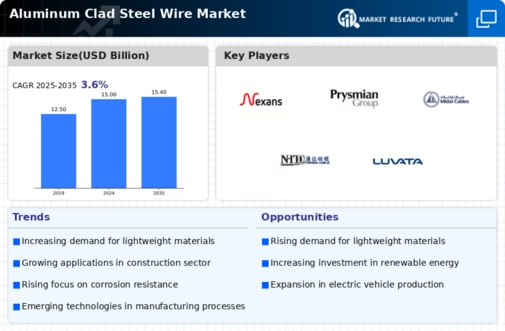Aluminum Clad Steel Wire Size
Aluminum Clad Steel Wire Market Growth Projections and Opportunities
The Aluminum Clad Steel Wire (ACSR) market is influenced by various factors that shape its dynamics and growth trajectory. One significant factor driving the market is the increasing demand for electricity transmission and distribution infrastructure. ACSR is widely used in overhead power transmission lines due to its high strength, conductivity, and corrosion resistance. As governments and utilities invest in upgrading and expanding their electrical grids to meet growing energy demand, the demand for ACSR wire increases, driving market growth.
Moreover, technological advancements play a crucial role in shaping the ACSR market. Continuous innovation in metallurgy, wire manufacturing processes, and coating technologies has led to the development of ACSR wires with improved mechanical properties, electrical conductivity, and durability. These advancements enable ACSR manufacturers to meet the evolving needs and stringent requirements of utility companies, driving market expansion and adoption of ACSR wire in new applications.
Another key factor influencing the ACSR market is the growing focus on renewable energy integration and grid modernization. As countries transition towards cleaner energy sources such as wind and solar power, there is a need to upgrade and expand the electrical grid infrastructure to accommodate decentralized generation and improve grid reliability. ACSR wire plays a crucial role in supporting the transmission of renewable energy from remote locations to urban centers, driving market growth.
Market regulations and standards also impact the ACSR market. ACSR wires used in electrical transmission and distribution applications must comply with various national and international standards related to mechanical strength, electrical conductivity, corrosion resistance, and environmental performance. Compliance with these standards is essential for manufacturers to ensure product quality and safety, driving investments in research and development and influencing market dynamics.
Furthermore, market competition drives innovation and product development in the ACSR market. The market is highly competitive, with numerous manufacturers competing for market share by offering a wide range of ACSR wire products tailored to specific utility requirements and performance standards. Competitive pricing strategies, product differentiation, and marketing initiatives drive market competition and influence consumer purchasing decisions.
Economic factors also play a significant role in shaping the ACSR market. Economic conditions such as GDP growth, construction activity, investment in infrastructure, and energy demand influence demand for ACSR wire in the utility sector. During periods of economic expansion, increased construction activity and investment in infrastructure drive demand for ACSR wire, while economic downturns may lead to temporary slowdowns in market growth as utilities delay or scale back projects.
Moreover, the availability and cost of raw materials impact the production and pricing of ACSR wire. Raw materials such as steel and aluminum are essential components of ACSR wire and are subject to price fluctuations and supply chain disruptions. Changes in raw material prices, availability, and quality can affect production costs and profit margins for ACSR manufacturers, influencing market dynamics.
Global market trends and geopolitical factors also influence the ACSR market. Factors such as trade policies, tariffs, currency exchange rates, and geopolitical tensions can impact market dynamics, trade flows, and supply chain logistics, affecting the availability and pricing of ACSR wire in different regions. Additionally, shifting energy policies, technological advancements, and industry consolidation shape the competitive landscape and market opportunities in the ACSR wire market.



 Source: Secondary Research, Primary Research, Market Research Future Database and Analyst Review
Source: Secondary Research, Primary Research, Market Research Future Database and Analyst Review





Leave a Comment